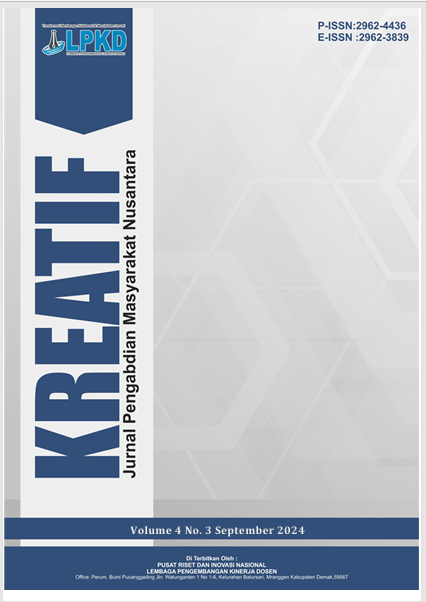Pengaruh Jumlah Penduduk, Pengangguran dan Pendidikan terhadap Tingkat Kemiskinan di Wilayah Indonesia Bagian Timur Tahun 2019-2023
DOI:
https://doi.org/10.55606/kreatif.v5i1.5687Keywords:
Education, Population, Poverty Rate, UnemploymentAbstract
This study aims to analyze the effect of population, unemployment rate, and education level on poverty levels in eastern Indonesia in 2019–2023. This study is a quantitative study with a descriptive approach using secondary data obtained from official publications of the Central Statistics Agency and other reliable sources. The analysis method used is the panel data regression analysis technique. The results of the study indicate that partially the variables of population, unemployment rate, and education level have a significant effect on poverty levels. Simultaneously, these three variables also have a significant effect on poverty levels in eastern Indonesia. These findings indicate that increasing education and decreasing unemployment rates can be effective strategies in reducing poverty. This study is expected to be a reference for local governments in formulating more targeted and sustainable socio-economic development policies.
References
Adhi Whisnu. (2011). Analisis pengaruh jumlah penduduk, PDRB, IPM, pengangguran terhadap tingkat kemiskinan di kabupaten/kota Jawa Tengah. Universitas Diponegoro.
Arsyad, L. (2016). Ekonomi pembangunan. UPP STIM YKPN.
Badan Pusat Statistik. (2023). Statistik Indonesia 2023. BPS.
Fajriansyah, S., & Chandriyanti, I. (2024). Pengaruh pertumbuhan ekonomi, tingkat pendidikan, dan laju pertumbuhan penduduk terhadap tingkat kemiskinan di Indonesia tahun 2019–2023. Edunomika, 8(2).
Firmansyah, A. (2021). Analisis klasifikasi dan strategi pengentasan kemiskinan di Indonesia. Jurnal Ekonomi dan Pembangunan, 9(2), 78–95.
Lestari. (2020). Hubungan pertumbuhan penduduk dengan kemiskinan di daerah terpencil.
Mankiw, N. G. (2018). Principles of economics (8th ed.). Cengage Learning.
Noor, M. A., & Mutmainah, S. (2019). Pengaruh tingkat pendidikan, pertumbuhan ekonomi, dan jumlah penduduk terhadap tingkat kemiskinan di Kabupaten Hulu Sungai Tengah. JIEP: Jurnal Ilmu Ekonomi dan Pembangunan, 2(4), 1028–1038.
Salsabila, A. Y., Imaningsih, N., & Wijaya, R. S. (2021). Pengaruh jumlah penduduk, jumlah pengangguran dan tingkat pendidikan terhadap pertumbuhan ekonomi di wilayah Gerbang Kertosusila. Jurnal Ekonomi Pembangunan, 7(1), 46–55.
Simbolon, C. M., et al. (2023). Analisis pengaruh pengangguran terbuka, human capital dan jumlah penduduk terhadap kemiskinan di Sumatera Utara.
Sukirno, S. (2004). Makro ekonomi: Teori pengantar (Edisi III). PT Raja Grafindo Persada.
Sukirno, S. (2019). Makroekonomi: Teori pengantar (Edisi ketiga). PT Raja Grafindo Persada.
Susanti, et al. (2020). Menunjukkan bahwa tingkat pengangguran yang tinggi memiliki korelasi positif dengan kemiskinan.
Wahyuni, E. T. (2020). Statistik deskriptif untuk penelitian ekonomi dan bisnis. UPP STIM YKPN.
Yusuf, A. M. (2017). Metode penelitian: Kualitatif, kuantitatif, dan penelitian gabungan.
Downloads
Published
How to Cite
Issue
Section
License
Copyright (c) 2025 KREATIF: Jurnal Pengabdian Masyarakat Nusantara

This work is licensed under a Creative Commons Attribution-ShareAlike 4.0 International License.








